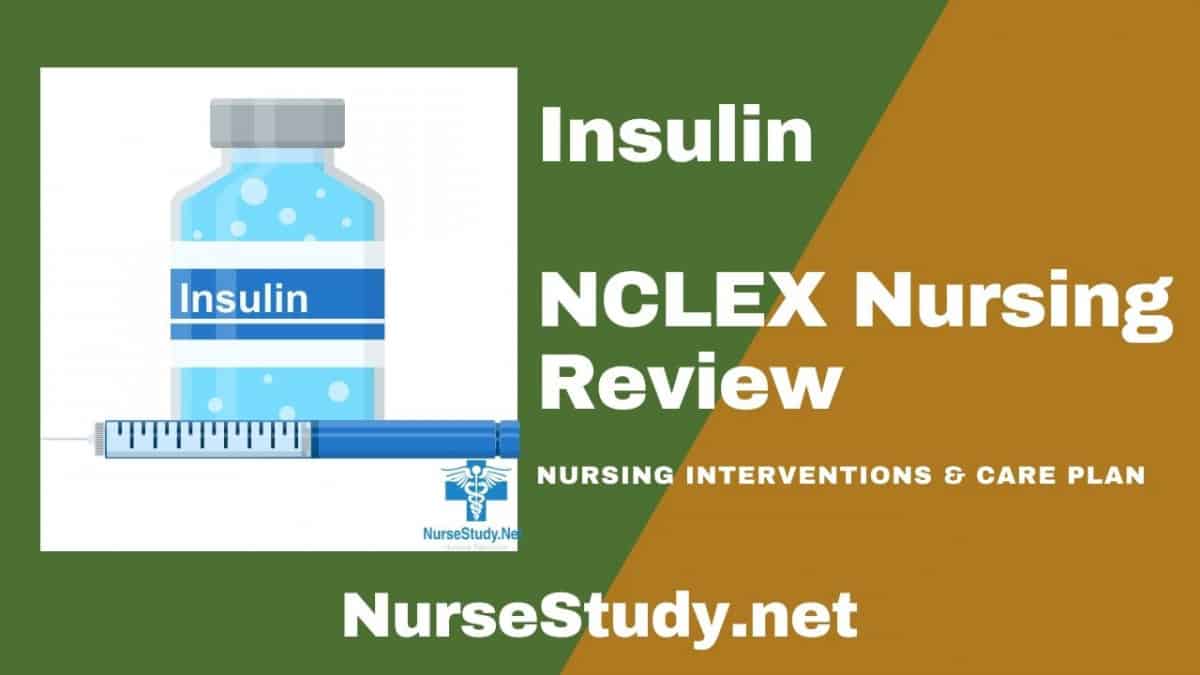Insulin is a hormone that plays a crucial role in regulating blood glucose levels. For individuals with diabetes, insulin therapy is often essential for managing their condition. As a nurse, understanding the proper administration, potential complications, and patient education regarding insulin is vital for providing quality care.
Generic names: There are several types of insulin, including:
- Rapid-acting: Insulin lispro, insulin aspart, insulin glulisine
- Short-acting: Regular (human) insulin
- Intermediate-acting: NPH (isophane) insulin
- Long-acting: Insulin glargine, insulin detemir, insulin degludec
Brand names: Humalog, NovoLog, Apidra, Humulin R, Novolin R, Humulin N, Novolin N, Lantus, Levemir, Tresiba
Pharmacologic class: Hormone
Therapeutic class: Antidiabetic
Mechanism of action: Insulin facilitates the uptake of glucose by cells, promotes the storage of glucose as glycogen, and inhibits glucose production in the liver. It also promotes protein synthesis and lipid storage.
Indications for use: Treatment of type 1 diabetes mellitus, some cases of type 2 diabetes mellitus, and gestational diabetes.
Precautions and contraindications: Hypersensitivity to insulin or any component of the formulation. Use caution in patients with hypoglycemia, renal or hepatic impairment, and during pregnancy or breastfeeding.
Drug Interactions
- Beta-blockers may mask signs of hypoglycemia.
- Corticosteroids, thiazide diuretics, and atypical antipsychotics may increase blood glucose levels.
- ACE inhibitors and fibrates may enhance the hypoglycemic effect of insulin
- Alcohol can enhance and prolong the hypoglycemic effect of insulin
Adverse Effects
- Hypoglycemia (most common and serious)
- Weight gain
- Lipodystrophy at injection sites
- Allergic reactions (rare)
- Edema
- Visual disturbances
Administration Considerations
Available preparations: Vials, prefilled pens, and cartridges for insulin pumps
Dosages: Highly individualized based on the patient’s blood glucose levels, body weight, diet, and physical activity. Regular monitoring and adjustments are necessary.
Route: Subcutaneous injection, intravenous (in hospital settings for certain types)
Onset, Peak, and Duration: Varies significantly depending on the type of insulin. For example:
- Rapid-acting: Onset 10-30 minutes, Peak 30-90 minutes, Duration 3-5 hours
- Long-acting: Onset 1-2 hours, No pronounced peak, Duration up to 24 hours
Nursing Considerations for Insulin
Related Nursing Diagnoses
- Risk for unstable blood glucose
- Deficient knowledge related to insulin administration and diabetes management
- Risk for injury related to hypoglycemia
- Imbalanced nutrition: more than body requirements related to insulin therapy
Nursing Assessment
- Assess the patient’s understanding of diabetes and insulin therapy.
- Evaluate the patient’s ability to self-administer insulin and monitor blood glucose levels.
- Assess for signs and symptoms of hypoglycemia or hyperglycemia.
- Review the patient’s dietary habits and physical activity level.
- Examine injection sites for signs of lipodystrophy or infection.
Nursing Interventions
- Administer insulin as prescribed, following the “5 rights” of medication administration.
- Rotate injection sites to prevent lipodystrophy.
- Monitor blood glucose levels before meals and at bedtime, or as ordered.
- Teach proper insulin storage and handling techniques.
- Educate patients on recognizing and managing hypoglycemia.
Patient Teaching Associated with Insulin
- Demonstrate proper insulin administration technique, including site rotation.
- Teach patients how to adjust insulin doses based on blood glucose readings, meals, and activity levels, as directed by their healthcare provider.
- Educate on the signs and symptoms of hypoglycemia and hyperglycemia and the appropriate actions to take.
- Instruct patients to always carry a fast-acting source of glucose (e.g., glucose tablets, juice) to treat hypoglycemia.
- Emphasize the importance of regular meals and snacks to maintain stable blood glucose levels.
- Teach patients how to safely dispose of used needles and lancets.
- Encourage regular foot care and eye examinations to prevent diabetes-related complications.
- Stress the importance of wearing medical identification indicating diabetes and insulin use.
This comprehensive guide to nursing considerations for insulin is designed to assist healthcare professionals in providing optimal care for patients using insulin therapy. By understanding the complexities of insulin administration, potential complications, and the importance of patient education, nurses can significantly improve outcomes for individuals managing diabetes.
References and Sources
- American Diabetes Association. (2021). Standards of Medical Care in Diabetes—2021. Diabetes Care, 44(Supplement 1), S1-S232.
- Hirsch, I. B., & Gaudiani, L. M. (2020). Using Insulin in Older Adults. Diabetes Spectrum, 33(3), 231-241. https://doi.org/10.2337/ds20-0002
- Kruger, D. F., & Valentine, V. (2022). Best Practices for Diabetes Insulin Injection Technique. The Journal for Nurse Practitioners, 18(3), 276-282. https://doi.org/10.1016/j.nurpra.2021.12.010
- Snaterse, M., & Kroon, A. A. (2021). Nursing Care for Patients with Diabetes Mellitus. In D. Pravikoff (Ed.), Nursing Reference Center Plus. EBSCO Information Services.
